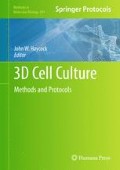Abstract
Injuries to the peripheral nervous system affect 1 in 1,000 individuals each year. The implication of sustaining such an injury is considerable with loss of sensory and/or motor function. The economic implications too are extensive running into millions of pounds (or dollars) annually for provision and support. The natural regrowth of peripheral nerves is possible for small gap injuries (of approximately 1–2 mm). However, patients with larger gap injuries require surgical intervention. The “gold standard” for repairing gap injuries is autografting; however, there are problems associated with this approach, and so, the use of nerve guidance conduits (NGC) is a realistic alternative. We outline in this chapter the development of an NGC that incorporates aligned poly-l-lactide fibres for supporting the growth of organised Schwann cells within a three-dimensional scaffold in vitro. A closed loop bioreactor for growing cells within NGC scaffolds is described together with a method of plasma deposition for modifying the microfibre surface chemistry (which improves the ability of Schwann cells to attach) and confocal microscopy for measuring cell viability and alignment within 3D constructs.
Access this chapter
Tax calculation will be finalised at checkout
Purchases are for personal use only
References
Noble, J., Munro, C.A., Prasad, V.S., and Midha, R. (1998) Analysis of upper and lower extremity peripheral nerve injuries in a population of patients with multiple injuries. J. Trauma 45, 116–122.
McKay Hart, A., Brannstrom, T., Wiberg, M., and Terenghi, G. (2002) Primary sensory neurons and satellite cells after peripheral axotomy in the adult rat: timecourse of cell death and elimination. Exp. Brain Res. 142, 308–318.
Schmidt, C.E. (2003) Neural tissue engineering: strategies for repair and regeneration. Annu. Rev. Biomed. Eng. 5, 293–347.
Yoshii, S. and Oka, M. (2001) Collagen filaments as a scaffold for nerve regeneration. J. Biomed. Mater. Res. 56, 400–405.
Suzuki, M., Itoh, S., Yamaguchi, I., Takakuda, K., Kobayashi, H., Shinomiya, K., et al. (2003) Tendon chitosan tubes covalently coupled with synthesized laminin peptides facilitate nerve regeneration in vivo. J. Neurosci. 72, 646–659.
Mikos, A.G. and Temenoff, J.S. (2000) Formation of highly porous biodegradable scaffolds for tissue engineering. J. Biotechnol. 3, 114–119.
Hall, S.M. (1986) The effect of inhibiting Schwann cell mitosis on the re-innervation of acellular autografts in the peripheral nervous system of the mouse. Neuropathol. Appl. Neurobiol. 12, 401–414.
Huang, Y.C. and Huang, Y.Y. (2006) Biomaterials and strategies for nerve regeneration. Artif. Organs 30, 514–522.
Kingham, P.J. and Terenghi, G. (2006) Bioengineered nerve regeneration and muscle reinnervation. J. Anat. 209, 511–526.
Salim, M., Wright, P.C. and McArthur, S.L. (2009) Studies of electroosmotic flow and the effects of protein adsorption in plasma-polymerized microchannel surfaces. Electrophoresis 30, 1877–1887.
Acknowledgements
We are grateful for financial support from the EPSRC (UK).
Author information
Authors and Affiliations
Corresponding author
Editor information
Editors and Affiliations
Rights and permissions
Copyright information
© 2011 Springer Science+Business Media, LLC
About this protocol
Cite this protocol
Murray-Dunning, C., McArthur, S.L., Sun, T., McKean, R., Ryan, A.J., Haycock, J.W. (2011). Three-Dimensional Alignment of Schwann Cells Using Hydrolysable Microfiber Scaffolds: Strategies for Peripheral Nerve Repair. In: Haycock, J. (eds) 3D Cell Culture. Methods in Molecular Biology, vol 695. Humana Press. https://doi.org/10.1007/978-1-60761-984-0_10
Download citation
DOI: https://doi.org/10.1007/978-1-60761-984-0_10
Published:
Publisher Name: Humana Press
Print ISBN: 978-1-60761-983-3
Online ISBN: 978-1-60761-984-0
eBook Packages: Springer Protocols

